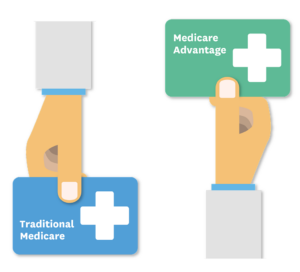Editor’s Note: This perspective was originally published on Health Affairs Forefront on April 26, 2024.
Medicare recipients have the opportunity every year, from October 15 to December 7, to choose to receive benefits in the upcoming year from traditional Medicare (TM) or Medicare Advantage (MA), as well as to enroll in a different private MA plan. However, for beneficiaries wanting to switch from MA to TM during these annual open enrollment periods, the questionable availability of supplemental insurance poses a significant disincentive because TM, unlike MA, lacks a limit on out-of-pocket costs. As a result, only 10 percent of TM beneficiaries with both Part A and Part B (a requirement for both Medigap and for MA) purchase no supplemental coverage, or “go bare.”
Supplemental insurance (Medigap) for individuals is governed by rules issued by states and the Centers for Medicare and Medicaid Services (CMS). For beneficiaries switching from MA, state regulations generally permit plans to deny coverage, impose waiting periods, or charge higher premiums. (Only Connecticut, Massachusetts, and New York require both “guaranteed issue” and “community rating,” a combination that assures beneficiaries the right to purchase Medigap and not be charged elevated premiums.) As a result, restrictions on the availability of Medigap disproportionately affect sicker beneficiaries, whom research shows are more likely to switch from MA to TM.
The disconnect between the statutory right to switch during an annual open season from MA to TM and the real-world barriers to obtaining Medigap has become increasingly problematic in light of the explosive growth of MA for beneficiaries with both Part A and Part B. In April 2023, 31.2 million (52.6 percent) beneficiaries in the 50 states and District of Columbia enrolled in MA, up from 6.6 million (16.9 percent) beneficiaries in 2006. Despite the total number of Medicare beneficiaries during this period increasing by 52.1 percent (20.3 million), TM beneficiaries decreased by 4.3 million (-13.3 percent). Between 2006 and 2019, 16.9 million beneficiaries switched from TM to MA.
The limited prospects for gaining Medigap coverage when re-joining TM tends to make selecting MA during open enrollment a one-way switch, as CMS and National Association of Insurance Commissioners starkly warn:
“In most cases, if you drop your Medigap policy to join a Medicare Advantage Plan, you won’t be able to get it back.”
This reality of beneficiary movement between TM and MA being a largely “one-way street” detracts from the ability of this market to serve beneficiaries well. After summarizing key Medigap features, this article explores policy options for facilitating the ability of beneficiaries wanting to disenroll from MA to purchase affordable Medigap policies.
Comparing TM and MA
CMS administers TM as a fee-for-service insurance program with few restrictions on access to care or choice of providers. For most services covered by Medicare, beneficiaries incur out-of-pocket costs such as a $1,632 deductible for an inpatient hospital admission and an annual deductible of $240, after which a 20 percent coinsurance applies for physician and other Part B services. In addition, the monthly Part D premium charged TM beneficiaries in 2024 for prescription drug plans averages $55.10.
Because TM does not limit the maximum cost beneficiaries can incur for Part A and Part B covered services, 90 percent of TM beneficiaries obtain supplemental coverage, with 41 percent purchasing Medigap, 32 percent covered in group plans as retirees by former employers, 16 percent in Medicaid, and 1 percent enrolled in other coverage. Medigap premiums vary widely based on specific plan parameters and state rules but generally run in the hundreds of dollars per month.
Private insurers contract with CMS to offer MA plans, generating profits if benefits cost less than their monthly capitation payments and losses if costs exceed revenues. Payments to MA plans in 2024 average 122 percent of what Medicare would have expected to spend if the beneficiaries participated in TM. Along with offering more generous benefits than TM, MA plans contract with restricted networks of providers and manage use through techniques such as prior authorization.
In 2024, 99 percent of beneficiaries have access to $0 premium MA plans; in 2023, 73 percent enrolled in $0 premium plans that offered prescription drug coverage, additional benefits (such as dental, vision, and gym memberships), and a maximum limit on out-of-pocket costs while avoiding hundreds of dollars in monthly Medigap and Part D premiums. In addition, 19 percent of MA plans reduce the $174.40 monthly premium charged all Part B participants.
The popularity of MA reflects lower costs and enhanced benefits, as well as many beneficiaries having participated in managed care while working and preferring systems of care that minimize paperwork and administrative complexity. While MA may deliver better quality and more efficient care, paying private plans an average of $2,329 in 2024 more than what TM beneficiaries would cost funds higher insurer profits as well as additional benefits. Beneficiaries initially attracted to MA may feel locked in due to their inability to purchase Medigap if they switch to TM, as highlighted by recent media stories.
Rules for Medigap premiums
Depending on state regulations, Medigap insurers may set premiums based on community rating, issue-age rating, or attained-age rating. Under each of the three, quite different premium-setting methodologies, insurers may annually request premium increases from state insurance commissioners for inflation and other changes (such as updated estimates of actuarial factors).
Community rating charges enrollees generally the same premium, regardless of age or gender, which results in younger beneficiaries paying more than their actuarially expected cost and older beneficiaries paying less. Issue-age rating sets premiums based on the age of a beneficiary when first enrolling in a Medigap policy, and premiums don’t increase as the individual ages. As a result, a beneficiary who joined a Medigap plan at age 65 will have lower premiums than a beneficiary of the same age who initially enrolled at age 68.
Attained-age rating sets premiums based on the current age of a beneficiary, allowing premiums to increase as an individual ages. Under attained-age rating, beneficiaries at 65 incur relatively low premiums that escalate annually, so that a beneficiary at age 75 pays more than one who is 65 would in that year; two beneficiaries of the same age pay the same premium, regardless of when each initially enrolled.
Guaranteed issue and rules for new and existing beneficiaries
Guaranteed issue means that an insurer cannot deny an applicant Medigap coverage, impose waiting periods, exclude preexisting medical conditions, or charge higher premiums on the basis of past or present health issues. After applicants enroll in a Medigap policy, federal rules generally prevent insurers from terminating coverage as long as premiums are paid.
Within six months of retirees enrolling in Medicare Part B, federal rules require guaranteed issue for Medigap, meaning insurers must accept applicants and not engage in medical underwriting. This precludes charging higher (health-related) premiums, imposing a waiting period, or not covering a preexisting condition. (Rules for the disabled vary by state.) State rules in Connecticut, Massachusetts, and New York require both community rating and guaranteed issue for Medigap, extending the federal protections for new retirees to all applicants. As result, beneficiaries in these three states can shift from MA to TM and enroll in Medigap for the same premium as those remaining in TM.
Federal rules convey “trial rights” to re-enter the Medigap market on a guaranteed-issue basis for retirees who either enrolled in MA when initially eligible for Medicare or dropped Medigap to join MA for the first time but want to switch to TM within their first year in MA. Medicare also requires guaranteed issue for other special circumstances, such as when a Medigap insurer goes bankrupt, an MA plan withdraws from a market (or a beneficiary moves out of the plan’s service area), employer coverage ends, or a Medigap or MA plan misleads a beneficiary or otherwise doesn’t follow applicable rules.
Adverse selection
In general, whenever consumers can choose whether or not to purchase health insurance, those expecting to have high medical expenses tend to be more likely to purchase coverage, a phenomenon called “adverse selection.” Because premiums reflect the projected medical spending by all of those who have purchased coverage, adding more expensive beneficiaries—adverse selection—will increase average costs and raise premiums. MA beneficiaries using more services are more likely to chafe at restrictions on their care arising from limited provider networks—such as cancer patients not being able to see the oncologist of their choice—or use management requirements—such as requiring prior authorization before covering an expensive drug or procedure. As a result, it is likely that those MA enrollees who want to enroll in Medigap when switching to TM are using more medical services than average MA beneficiaries. To the extent that this is the case, guaranteed issue would increase Medigap premiums, the reason most states do not require it.
The expected increase in Medigap premiums from assuring that MA enrollees who switch to TM can access affordable Medigap coverage would depend on the degree of adverse selection. It would also depend on the number of beneficiaries who, when switching to TM, enroll in Medigap compared to the number of overall Medigap enrollees. The degree of adverse selection for those switching to TM would likely increase if beneficiaries leaving MA had assured access to affordable Medigap coverage. A study of disenrollment from MA analyzing 2014 and 2015 data found that only 3.7 percent (0.5 million) of 13.9 million MA beneficiaries switched to TM, but high-need and dually eligible beneficiaries had substantially higher rates of switching than Medicare-only, non-high-need beneficiaries.
Improved access to Medigap would also lead to more beneficiaries switching to TM, increasing the percentage of switchers in the Medigap pool. Estimating how much and for how many years the expected spending of MA switchers would remain above average poses an additional complication in accounting for their effects on Medigap premiums.
Possible policy approaches to reforming Medigap
To make affordable supplemental coverage more accessible to MA enrollees who want to switch to TM, federal or state policy makers could expand the circumstances under which Medigap insurers would be required to set premiums using guaranteed issue or both guaranteed issue and community rating. Policy makers could apply the new requirements to all Medigap plans or impose the reforms on only a limited number of the benefit designs that federal rules currently permit.
The potential resulting increase in Medigap premiums would depend on the parameters of the proposed reform, which would include the circumstances under which beneficiaries would qualify for liberalized rules; whether guaranteed issue, limitations on medical underwriting, or community rating would be required; and the types of Medigap policies to which the new requirements would apply. A broader Medigap policy question (which is beyond the scope of this article) is whether reforms limiting medical underwriting and differential premiums in Medigap should apply only to beneficiaries switching from MA or more broadly to all TM beneficiaries seeking a Medigap plan.
The tradeoffs inherent in potential reforms
The potential premium increase for those currently enrolled in Medigap could be reduced or completely offset by assessing a surcharge on beneficiaries switching from MA who enroll in Medigap. The Medicare Actuary could determine the amount and duration of the Medigap surcharge, with the estimate periodically updated, in a process similar to how the Actuary estimates the annual Part B premium. The surcharge could be set to avoid an increase in the average Medigap premium due to beneficiaries switching from MA and enrolling in Medigap. Alternatively, the surcharge could be set lower to partially offset additional costs, which would split the increased costs between the higher premiums paid by switchers and incrementally higher overall Medigap premiums. Obviously, the greater the portion of additional costs borne by switchers, in both dollar amount and duration, the less effective reform would be in eliminating the disincentive to switch from MA to TM in the first place. Mandating improvement in the completeness of MA encounter data and their comparability to TM claims data would facilitate setting the percentage of the surcharge.
Reforming Medigap could be done either by the federal government or by states. Federal requirements could lead to uniformity across states, which would facilitate Medicare beneficiaries becoming aware of the policy. Because insurance regulation is generally a state function, opposition to the reform might be more of a barrier at the state level due to the political influence of the insurance industry, led by companies with large Medigap books of business.
However, insurers more focused on MA might not oppose reforming Medigap policy for two reasons. One is the possibility that more beneficiaries would enroll in MA without the risk of being unable to gain Medigap coverage if they want to rejoin TM. The other is that public acceptance of MA might be greater if those most dissatisfied with their experience in MA are allowed to return to TM rather than continuing to seethe in MA.
MA overpayments could be tapped to add catastrophic protection in TM, reducing Medigap plan costs
The enhanced benefits offered by MA plans—subsidized by Medicare paying plans $83 billion more in 2024 than it would have been spent for the same beneficiaries in TM, according to the Medicare Payment Advisory Commission—contribute significantly to the popularity of MA. The continuing exposure to significant out-of-pocket spending—especially given that MA but not TM limits the maximum a beneficiary might pay in a year for Part A and Part B services—underscores why 90 percent of TM beneficiaries have supplemental coverage.
If Medigap and MA reform proceeded in parallel, Congress could combine reducing MA overpayments with enhancing the traditional Medicare benefit by adding catastrophic protection. Having Medicare limit maximum out-of-pocket costs would lower Medigap costs, with the lower premiums potentially offsetting higher costs associated with increased requirements for guaranteed issue and limiting medical underwriting. Under current rules setting MA payment rates, any increase in TM costs associated with a catastrophic benefit limiting maximum out-of-pocket costs would flow through to somewhat increased payments to plans.
Authors’ note
This work was supported by a grant to the University of Southern California from Arnold Venture.
Ginsburg, P. B., & Lieberman, S. M. (2024). Improving Access To Medigap When Beneficiaries Leave Medicare Advantage. Health Affairs Forefront.
DOI:10.1377/forefront.20240424.570239
Copyright © [2024] Health Affairs by Project HOPE – The People-to-People Health Foundation, Inc.
Sign up for Schaeffer Center news


